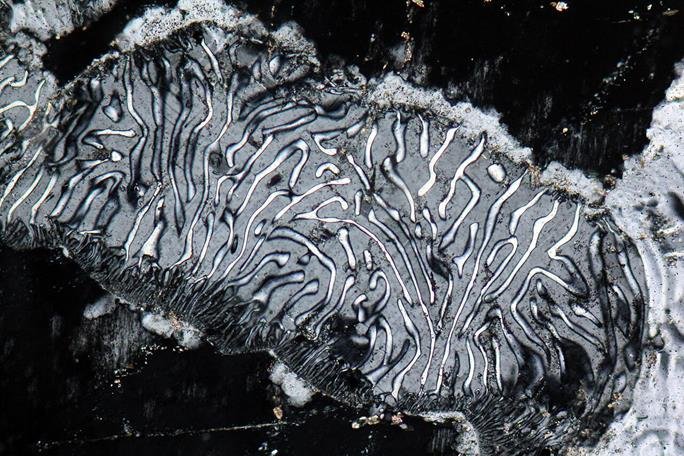Myrmekite describes the intergrowth of worm-like or vermicular quartz inside sodium-plagioclase (Na-plagioclase) in plutonic rocks.
It usually occurs at the Na-plagioclase contact with potassium-feldspar (K-feldspar). However, it can act as a rim between K-feldspar and more calcium plagioclase.
This wormy intergrowth of quartz in sodium plagioclase, usually albite, occurs towards the margin. It often projects into K-feldspar, creating a region shaped like a wart.
This wart-like region with wormy quartz and Na-plagioclase intergrowth is the origin of the word myrmekite. Myrkeite in Ancient Greek means wart.
Note: Sodium plagioclase (Na-plagioclase) is an alkali feldspar. Also, it is a plagioclase.
Lastly, texture or fabric formed by the intergrowth of wormy quartz within sodium-rich feldspar visible in thin sections is known as myrmekitic texture. You cannot see them with unaided eyes.

More about myrmekite and symplectite
Myrmekite is one of the symplectite textures. Symplectite is a term that describes worm-like or vermiform intergrowth between two minerals. It results from a reaction between unstable minerals.
In the case of myrmekite, the intergrowth is between worm-like quartz blebs and plagioclase.
Symplectitic texture occurs in other rocks and minerals, too. For instance, eclogite forms a fine-grained, colorless plagioclase and amphibole symplectite at low pressure and temperature. This means it is unstable in such conditions.
Similarly, wormy intergrowth can happen in chalcopyrite in bornite and between tennantite and galena.
Which rocks have myrmekitic texture
Myrmekititic is common felsic plutonic rocks. These are acidic rocks high in silica and light-colored minerals like feldspars and quartz. These include granitoids and syenites.
However, it can occur in intermediate rocks like diorite or metamorphic rocks like gneisses.
How do myremekites form?
Myrmekite intergrowth forms from a reaction during cooling after solidification (subsolidus reaction). It indicates that the rock hadn’t achieved chemical equilibrium after it solidified.
This reaction often involves deformation. However, deformation doesn’t always happen. Some undeformed rocks have myrmekitic texture.
By looking at the products formed, it is possible to know the chemical reactions involved. This is only true for simple reactions, not complex ones.
How myrmekitic fabric forms is debatable. However, it involves the direct crystallization of quartz or the replacement of potassium feldspar by a vermiculite quartz.
However, it may originate from subsolidus unmixing sodium-bearing plagioclase in a feldspar ternary system open to excess silicon.
Part of the reaction involves the replacement of K-feldspar with albite and ca-bearing plagioclase albitization via these equations.
- 2KAlSi3O8 (orthoclase) + Na2O (sodium oxide) → 2NaAlSi3O8 (albite) + K2O (potassium oxide)
- 2CaAl2Si2O8 (anorthite) Na2O + 2SiO2 (silica) + 2NaAlSi3O8 (albite) + 2CaO (calcium oxide) + Al2O3 (aluminum oxide).
Other intergrowths
Other intergrowths that involve feldspars include granophyric, graphic, rapakivi, and antirapakivi textures.
Granophyric texture often has irregular, usually worm-like quartz intergrown with alkali feldspar (k-feldspar or sodic plagioclase). It can form in interstices if the granophyre rock is porphyritic.
Granophyric texture likely forms from simultaneous quartz and feldspar crystallization from the last or residual melt.
On the other hand, graphic texture or graphic granite is a quartz and K-feldspar intergrowth in which quartz is enclosed by large K-feldspar, creating an appearance of runic, cuneiform, or hieroglyphic writing.
It forms from the simultaneous crystallization of quartz and perthitic K-feldspar common in granite pegmatites. Sometimes, the quartz may have an irregular branch network.
Lastly, rapakivi texture or granite forms when sodic plagioclase rims or mantle k-feldspar phenocrysts are common in felsic rocks. In contrast, the antirapakivi texture will have a k-feldspar rim forming or crystallizing on plagioclase phenocrysts.
